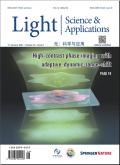Challenges and opportunities in next-generation LED therapeutic devices.
IF 23.4
Q1 OPTICS
引用次数: 0
Abstract
Phototherapy offers advantages of non-invasiveness, cost-effectiveness, localized treatment, and potential for home-based care across various medical conditions. However, its adoption is hindered by the large size, limited safety, and professional operation requirements of current phototherapeutic devices. Unlike bulky laser phototherapeutic devices, wearable and implantable LED-based devices overcome these limitations, offering improved safety, portability, and uniform light distribution, making them promising prototypes for next-generation phototherapies. This review explores the home-care potentials of phototherapy from a clinical application perspective and provides a comprehensive overview of its therapeutic mechanisms and diverse applications. By synthesizing the latest advancements and cutting-edge research, we identify key clinical challenges associated with wearable and implantable phototherapy devices and propose fundamental strategies to address these limitations, such as miniaturization, biocompatibility, and energy efficiency. Furthermore, we draw on interdisciplinary cutting-edge research to address the challenges faced by phototherapy devices. We also emphasize the critical value of integrating artificial intelligence (AI) and flexible sensing technologies within phototherapy systems. Specific methods and potential applications are discussed for effectively integrating phototherapy systems with AI algorithms to establish a closed-loop diagnostic and therapeutic system. Grounded in clinical applications, we outline concrete research directions for developing next-generation LED-based phototherapy devices. This review delivers valuable insights for clinicians leveraging phototherapy and offers a roadmap for researchers in material science, flexible electronics, and AI, fostering interdisciplinary innovations to advance future phototherapy applications.下一代LED治疗设备的挑战与机遇。
光疗具有非侵入性、成本效益、局部治疗以及在各种医疗条件下家庭护理的潜力等优点。然而,目前光疗设备的尺寸大、安全性有限、操作要求专业等因素阻碍了其采用。与体积庞大的激光光疗设备不同,基于可穿戴和植入式led的设备克服了这些限制,提供了更好的安全性、便携性和均匀的光分布,使它们成为下一代光疗的有希望的原型。本文从临床应用的角度探讨了光疗的家庭护理潜力,并对其治疗机制和多种应用进行了综述。通过综合最新进展和前沿研究,我们确定了与可穿戴和植入式光疗设备相关的关键临床挑战,并提出了解决这些限制的基本策略,如小型化、生物相容性和能源效率。此外,我们利用跨学科的前沿研究来解决光疗设备面临的挑战。我们还强调了在光疗系统中集成人工智能(AI)和柔性传感技术的关键价值。讨论了将光疗系统与人工智能算法有效集成,建立闭环诊疗系统的具体方法和潜在应用。基于临床应用,我们概述了下一代基于led的光疗设备的具体研究方向。这篇综述为临床医生利用光疗提供了有价值的见解,并为材料科学、柔性电子和人工智能的研究人员提供了路线图,促进跨学科创新,以推进未来光疗的应用。
本文章由计算机程序翻译,如有差异,请以英文原文为准。
求助全文
约1分钟内获得全文
求助全文
来源期刊

Light-Science & Applications
数理科学, 物理学I, 光学, 凝聚态物性 II :电子结构、电学、磁学和光学性质, 无机非金属材料, 无机非金属类光电信息与功能材料, 工程与材料, 信息科学, 光学和光电子学, 光学和光电子材料, 非线性光学与量子光学
自引率
0.00%
发文量
803
审稿时长
2.1 months
 求助内容:
求助内容: 应助结果提醒方式:
应助结果提醒方式:


